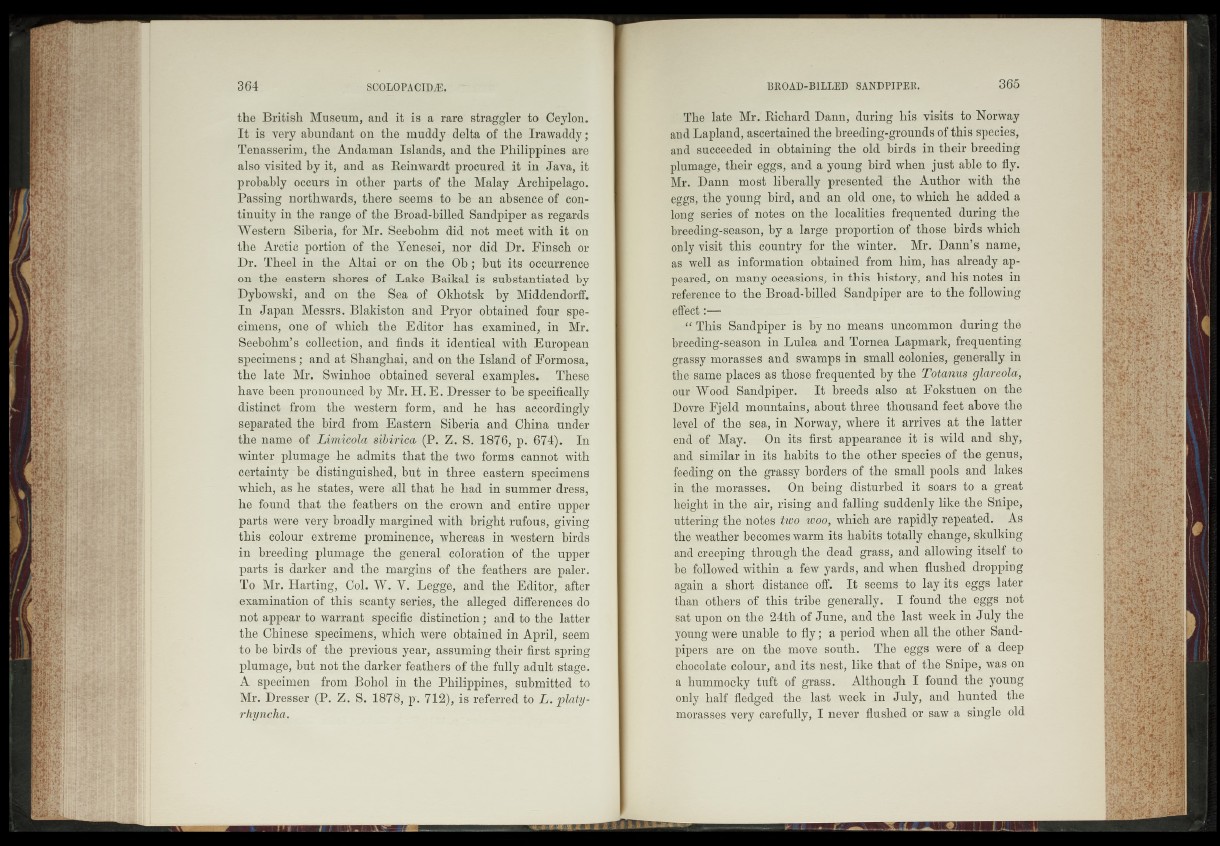
the British Museum, and it is a rare straggler to Ceylon.
It is very abundant on the muddy delta of the Irawaddy;
Tenasserim, the Andaman Islands, and the Philippines are
also; visited by it, and as Reinwardt procured it in Java, it
probably occurs in other parts of the Malay Archipelago.
Passing northwards, there seems to be- an absence of continuity
in the range of the Broad-hilled Sandpiper as regards
Western Siberia, for Mr. Seebohïn did not meet with it on
the Arctic portion of the Yenesei, nor did Dr. Finsch or
Dr. Theel in the Altai -or on the Oh; hut-its occurrence
on the eastern shores of Lake Baikal is substantiated hy
Dybowski, and on the Sea of Okhotsk hy Middendorff.
In Japan Messrs. Blakistoh and. Pryor ^obtained four specimens^
one of which the -Editor ' has 'examined, in Mr.
Seehohm’s collection, and finds it identical -with European
specimens; and at-Shanghai, and on the Island of Formosa,
the late Mr. Swinhoe obtained several examples. ' These
have been pronounced hy Mr. H. E. Dresser' tor he specifically
distinct from the western form, and he has accordingly
separated the bird from Eastern Siberia „and;China under
the name-of Limic&la sibirica £P._ Z. S. 1876, p. 67i4),^t|®n
winter plumage -he admits that the two - forms cannot with
certainty; bet distinguished, but in three 'eastern,,specimens
which, as he states, were £fll tha||he had in summer.JaSess,
he found that, the feathers, on the/crown ‘and entire upper
parts were very broadly margined with bright, rufous, ■giving
this colour -extreme prominence, whereas in western - birds
in breeding plumage -the. general colefatlen of thé, upper
parts is darker and the margins of the.- feathpps- are paler.
Tq . Mr. Harting. W. V. Legggj^and- the Editor,' after
examination qf^this scanty-serfej, the alleged differences do
not appear to warrant specific ^distinction; and to -the latter
the Chinese specimens, which; wegq-„obtained in April,-.seem
to be birds of the „.previous year, assuming thgir first spring
plumage, but -ngt the darker feathers1 of the fully adultr-iStage,
A specimen from Bohol in,the-Philippines,"-„submitted to
Mr. Dresser'(P. Z .sS. 1878, p. 712)^8 referred tq'L. platy-
rhyncha.
The late Mr, Richard Dann, during his visits to Norway
an d Lapland, ascertained the breeding-grounds of this speciès/
and succeeded in obtaining the old birds in their breeding
plumage, their eggs, and a young bird when just able to fly;
Mr. Dann most liberally presented“ the Author with the
eggs, -the young -bird, .and an old one, to which he added a
long séries of notes on the localities frequented during the
breeding-season, by a large proportion of those birds which
only visit this country for the winter.. Mr. Dann’s name;
as well as information . obtained from him, has already api
peared, on i many occasions, in this history, and his notes in
reference to the Broad-billed Sandpiper are to the followiifg
effect —
tsrFThis .Sandpiper É | hy no means uncommon during thé
breeding-season in Lulea and Tornea Lapmark, frequenting
grassy'morasses and swamps in small colonies, generally in
the-same places asdfiose frequented by the Tot anus- glnr.eoM,
our Woidï Sandpiper,; It breeds also .at Fokstuen on the
®PC'Fjeld mountains, about three thousand feet above the
level ipi- the .sea,- in.- Norway, where it' arrivés «at the latter
enl^tof- May.' -On .its first appearance it is* wild and shy,
and similar in its habits to the .other,species ®f*'-the genus,
feeding'on ihéigrassyhbrlsèrB of the small pools and lakes
i l the ÈaoïàEses.1 heteg disturijjgl .’it soars to a great
height in the «air, rjsipg; and suddenly .like^the Snipe,
uttering the not:es.:i^-iMoa; which are rapidly repeated, As
tie weather becomes warm its habits-totally change, skulking
creeping .through-the dead .grass, :and allowing itself t:è -
b^rfollowed within a féw yards, and when .flushed dropping
again a ■ short-cdistahce; off. It seems to lay its eggs .later
than ht-berg- ôhfthis, tribe generally. I found the/ eggs hot
sat upon op the 24th of June, and the lastwflek in July the
yhungwefe unable /to. fly ; a period when all the. other Sandpipers
'are^.phr .thel move '.south. The -egga .were of a deep
:%hécolate-coloür, an.d;its hegt, like that,of: fhe Snipe,- was h i
a hummocky „tuft of; grass,. Although .-I founds the young
only half ' fledgedj-hhe.„ last week in July, and hunted' the
itérasses very carefully, I never flushed .or saw a single .old